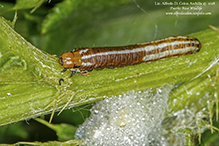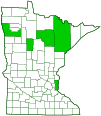Ragwort stem borer moth
(Papaipema insulidens)
Conservation • Description • Habitat • Ecology • Distribution • Taxonomy
| Hodges # | 9488 |
||
Conservation Status |
|||
| IUCN Red List | LC - Least Concern |
||
| NatureServe | N4 - Apparently Secure SNR - Unranked |
||
| Minnesota | not listed |
||
Description |
Ragwort stem borer moth is a mid-sized, late season, borer moth. There are two unconnected populations in North America. The eastern population extends from Maine to Minnesota south to North Carolina and Nebraska and includes adjacent Canadian provinces. The western population is in British Columbia, Washington, Oregon, and Idaho. The species is common within its range, uncommon in Minnesota where it is at the northwest extent of the range of the eastern population. It is found in the late summer and fall mostly in wetlands and alongside rivers and streams, but also in forests, open areas, and disturbed sites. Adults are 11 ⁄16″ (18 mm) long and have a wingspan of 1¼″ to 1 7 ⁄16″ (32 to 37 mm). The forewing is ⅝″ to ¾″ (16 to 20 mm) long, broadly triangular, and slightly hooked at the tip. Dark areas transition smoothly (grade) into adjacent light areas. The dark areas reddish-orange, the light areas are yellow or cream-colored. The ground color is mostly reddish-orange. The basal area, the wing tip, the basal half of the inner margin, and a narrow patch on the leading (costal) margin are pale. The subterminal area is purplish-gray. The antemedial (AM) line is indistinct. The median line is reddish-brown to dark brown and undulating. The postmedial (PM) line is dark brown, smooth, and broadly curved. The terminal line is dark reddish-brown and thin. The fringe is dark purplish-gray. There is a circular spot (orbicular spot) in the upper median area, a club-shaped spot (claviform spot) between the orbicular spot and the inner margin, and a kidney-shaped spot (reniform spot) at the end of the discal cell. The orbicular spot is white with a thin, dark reddish-brown outline and a dark spot in the center. The claviform spot is large and white but broken into three small spots with dark brown outlines. The reniform spot is white with a thin, dark reddish-brown outline, a yellow to reddish-brown crescent in the center, and dark reddish-brown veins. The hindwings are light yellowish-gray tinged with reddish and gray. The antennae are slender and thread-like on the female, bead-like on the male. |
Size |
Total length: 11 ⁄16″ (18 mm) Wingspan: 1¼″ to 1 7 ⁄16″ (32 to 37 mm) |
Similar Species |
Habitat |
Wetlands, riparian areas, forests, open areas |
Ecology |
Season |
Late summer and fall |
Behavior |
Adults are active at night and will come to lights, but they do not wander far from wetlands. Caterpillars bore into the roots, underground stems (rhizomes), and aerial stems of host plants and are rarely seen. |
Life Cycle |
The eggs are laid in the fall and hatch in the spring. The larvae pupate in the summer and emerge as adults in late summer. |
Larva Hosts |
Various plants in the Apiaceae (carrot) family, including spotted water hemlock, purplestem angelica, and hemlock water-parsnip. |
Adult Food |
|
Distribution |
||
|
Sources |
|
| 8/31/2025 | ||
Occurrence |
||
Common This species is much less common than its host plants. |
||
Taxonomy |
|
Order |
|
Superfamily |
Noctuoidea (Owlet Moths and Allies) |
Family |
Noctuidae (cutworm moths and allies) |
Subfamily |
|
Tribe |
Apameini (arches) |
Genus |
Papaipema |
Family Species |
|
Subordinate Taxa |
|
|
|
Synonyms |
|
Gortyna birdi Papaipema birdi Papaipema pertincta |
|
Common Names |
|
ragwort stem borer moth umbellifer borer moth |
|
The common name refers to this species being found on tansy ragwort in the Northwest. |
|
Glossary
Antemedial (AM) line
A thin line separating the basal area and the median area of the forewing of Lepidoptera.
Costal margin
The leading edge of the forewing of insects.
Orbicular spot
A circular spot or outline in the upper median area near the antemedial line on the forewing of many moths.
Postmedial (PM) line
A thin line separating the median area and the postmedial area of the forewing of Lepidoptera.
Reniform spot
A kidney-shaped spot or outline in the lower median area near the PM line on the forewing of many moths.
Rhizome
A horizontal, usually underground stem. It serves as a reproductive structure, producing roots below and shoots above at the nodes.
Visitor Photos |
Share your photo of this insect. |
||
This button not working for you? |
||
Alfredo Colon |
 |
MinnesotaSeasons.com Photos |
|

Slideshows |
|

Visitor Videos |
Share your video of this insect. |
||
This button not working for you? |
||
|
Other Videos |
|

|
Created: 12/9/2019 Last Updated: © MinnesotaSeasons.com. All rights reserved. |


